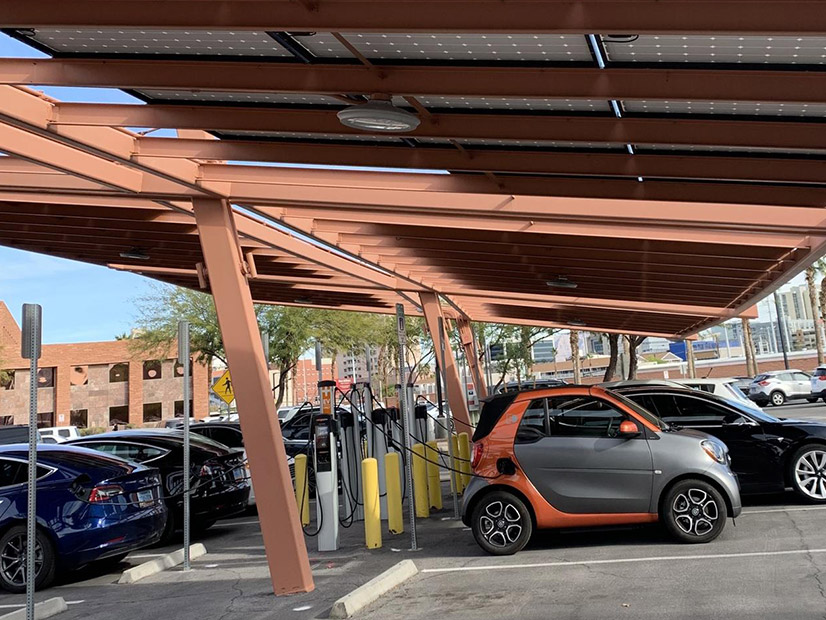Continue reading "Many Next Steps to Follow Passage of Nevada Energy Bill"
The Nevada governor’s office will soon be inviting interested parties to apply for a seat on a new task force that will advise the governor and lawmakers on bringing the state into an RTO.
The Regional Transmission Coordination Task Force is the product of Senate Bill 448, a wide ranging energy bill that Gov. Steve Sisolak signed into law on June 10.
The bill, by Sen. Chris Brooks (D), has many provisions that will be implemented in stages. One of the initial steps will be the formation of the task force, to be facilitated by the Governor’s Office of Energy (GOE).
GOE Director David Bobzien said the governor’s office will post a notice, likely over the summer, inviting applicants to serve on the task force. The group will have about 20 members representing an array of interests. (See list of task force membership below.)
The governor will appoint the task force members, who will not be paid. The group will meet at least twice a year. Its first report will be due by Nov. 30, 2022.
“We do anticipate there’s going to be a lot of interest,” Bobzien told RTO Insider.
The task force will help address issues such as the potential costs and benefits of joining or creating an RTO.
The group will look at policies to help bring transmission providers into an RTO by Jan. 1, 2030. Under SB448, the Public Utilities Commission of Nevada (PUCN) will require every transmission provider in the state to join an RTO by that date, although waivers will be possible.
Sept. 1 Deadline
While the task force is getting organized, the state’s electric utility, NV Energy, faces a Sept. 1 deadline for two key filings required by SB448.
The utility must file a plan with PUCN by Sept. 1 to build its Greenlink North transmission line. The project would connect northwest and northeast Nevada and form a triangle with the existing One Nevada transmission line and Greenlink West, a project that NV Energy received approval to build in March. (See Regulators Greenlight NV Energy’s Greenlink West.)
PUCN then will have 165 days to approve the plan. The goal is to have Greenlink North placed into service by Dec. 31, 2028.
Although PUCN in March approved conceptual designs, permitting and land acquisition for Greenlink North, Brooks said SB448 adds certainty that construction of the project will be approved.
“This shortens the time frame,” Brooks told RTO Insider. “That was the whole point — to expedite the process.”
And the increased certainty around Greenlink may spur other transmission projects, he said.
“That just opens up a lot more opportunities for other transmission developers,” Brooks said.
Sept. 1 is also the deadline for NV Energy to submit a plan for $100 million in electric vehicle charging infrastructure.

The plan, which will cover January 2022 to December 2024, will include investments in the following programs:
- an interstate corridor charging depot program;
- a public agency EV charging program;
- a charging program for transit vehicles and school buses;
- an urban charging program, geared toward drivers who can’t charge their EVs at home or at work; and
- an outdoor recreation and tourism charging program.
At least 40% of spending in the plan must go toward investments made in or benefiting historically underserved communities.
NV Energy supported SB448.
“Senate Bill 448 will transform Nevada’s clean energy landscape, create thousands of good paying jobs, and ensure Nevada’s underserved and low-income communities benefit from this energy transformation,” NV Energy spokesperson Jennifer Schuricht said on Friday.
Rate Rider Revived
The Nevada legislature in 2013 established a program called the Economic Development Electric Rate Rider, which gave eligible businesses discounts on their electric bills for a number of years. The program’s purpose was to attract new commercial and industrial businesses to Nevada.
The program closed to new participants at the end of 2017, with about half of its 50 MW of capacity remaining. SB448 reopens the program, setting a new deadline of Dec. 31, 2024, for businesses to apply.
The Governor’s Office of Economic Development is in the process of developing guidance on how to implement the program, according to GOED spokesperson Greg Bortolin.
SB448 will also expand the Renewable Energy Tax Abatement (RETA) program that gives tax breaks to renewable energy generation projects. The bill will clarify that the tax break is also available to energy storage projects, or hybrid projects consisting of renewable generation and storage.
Bobzien expects rulemaking to start this summer for the expansion of RETA.
Task Force Membership
Nevada’s governor will appoint members of the Regional Transmission Coordination Task Force and choose a chairperson for the panel. Other seats on the task force will be filled with representatives of the following:
- an electric utility serving densely populated counties
- an organization that represents rural electric cooperatives and municipally owned electric utilities in the state
- the Colorado River Commission
- a transmission line development company
- the large-scale solar energy industry
- the geothermal energy industry
- a data center business
- the mining industry
- gaming and resort businesses
- a labor organization
- an environmental organization
- the Nevada Indian Commission representative
- the Governor’s Office of Energy
- the Governor’s Office of Economic Development
- the Nevada state Senate: two members nominated by the Senate Majority Leader, including at least one minority-party member
- the state Assembly: two members nominated by the Assembly speaker, including at least one minority-party member
- the general public (up to three members)
In addition, the task force will include the following non-voting members:
- a PUCN representative and
- a representative of the Bureau of Consumer Protection in the Attorney General’s Office.




